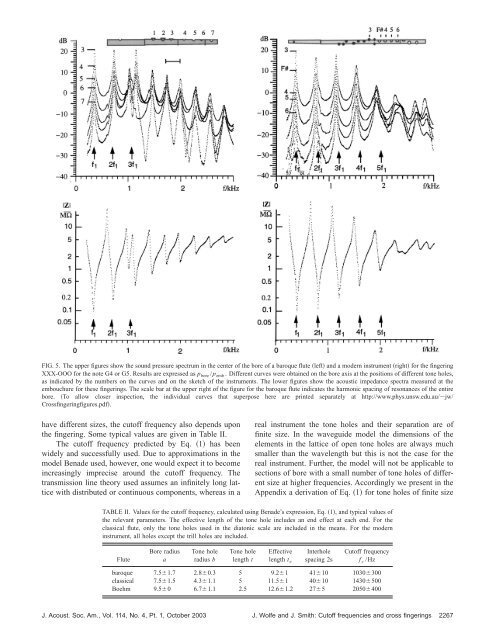Cutoff frequencies and cross fingerings in ... - School of Physics
Cutoff frequencies and cross fingerings in ... - School of Physics
Cutoff frequencies and cross fingerings in ... - School of Physics
Create successful ePaper yourself
Turn your PDF publications into a flip-book with our unique Google optimized e-Paper software.
FIG. 5. The upper figures show the sound pressure spectrum <strong>in</strong> the center <strong>of</strong> the bore <strong>of</strong> a baroque flute left <strong>and</strong> a modern <strong>in</strong>strument right for the f<strong>in</strong>ger<strong>in</strong>g<br />
XXX-OOO for the note G4 or G5. Results are expressed as p bore /p emb . Different curves were obta<strong>in</strong>ed on the bore axis at the positions <strong>of</strong> different tone holes,<br />
as <strong>in</strong>dicated by the numbers on the curves <strong>and</strong> on the sketch <strong>of</strong> the <strong>in</strong>struments. The lower figures show the acoustic impedance spectra measured at the<br />
embouchure for these <strong>f<strong>in</strong>ger<strong>in</strong>gs</strong>. The scale bar at the upper right <strong>of</strong> the figure for the baroque flute <strong>in</strong>dicates the harmonic spac<strong>in</strong>g <strong>of</strong> resonances <strong>of</strong> the entire<br />
bore. To allow closer <strong>in</strong>spection, the <strong>in</strong>dividual curves that superpose here are pr<strong>in</strong>ted separately at http://www.phys.unsw.edu.au/jw/<br />
Crossf<strong>in</strong>ger<strong>in</strong>gfigures.pdf.<br />
have different sizes, the cut<strong>of</strong>f frequency also depends upon<br />
the f<strong>in</strong>ger<strong>in</strong>g. Some typical values are given <strong>in</strong> Table II.<br />
The cut<strong>of</strong>f frequency predicted by Eq. 1 has been<br />
widely <strong>and</strong> successfully used. Due to approximations <strong>in</strong> the<br />
model Benade used, however, one would expect it to become<br />
<strong>in</strong>creas<strong>in</strong>gly imprecise around the cut<strong>of</strong>f frequency. The<br />
transmission l<strong>in</strong>e theory used assumes an <strong>in</strong>f<strong>in</strong>itely long lattice<br />
with distributed or cont<strong>in</strong>uous components, whereas <strong>in</strong> a<br />
real <strong>in</strong>strument the tone holes <strong>and</strong> their separation are <strong>of</strong><br />
f<strong>in</strong>ite size. In the waveguide model the dimensions <strong>of</strong> the<br />
elements <strong>in</strong> the lattice <strong>of</strong> open tone holes are always much<br />
smaller than the wavelength but this is not the case for the<br />
real <strong>in</strong>strument. Further, the model will not be applicable to<br />
sections <strong>of</strong> bore with a small number <strong>of</strong> tone holes <strong>of</strong> different<br />
size at higher <strong>frequencies</strong>. Accord<strong>in</strong>gly we present <strong>in</strong> the<br />
Appendix a derivation <strong>of</strong> Eq. 1 for tone holes <strong>of</strong> f<strong>in</strong>ite size<br />
TABLE II. Values for the cut<strong>of</strong>f frequency, calculated us<strong>in</strong>g Benade’s expression, Eq. 1, <strong>and</strong> typical values <strong>of</strong><br />
the relevant parameters. The effective length <strong>of</strong> the tone hole <strong>in</strong>cludes an end effect at each end. For the<br />
classical flute, only the tone holes used <strong>in</strong> the diatonic scale are <strong>in</strong>cluded <strong>in</strong> the means. For the modern<br />
<strong>in</strong>strument, all holes except the trill holes are <strong>in</strong>cluded.<br />
Flute<br />
Bore radius<br />
a<br />
Tone hole<br />
radius b<br />
Tone hole<br />
length t<br />
Effective<br />
length t e<br />
Interhole<br />
spac<strong>in</strong>g 2s<br />
<strong>Cut<strong>of</strong>f</strong> frequency<br />
f c /Hz<br />
baroque 7.51.7 2.80.3 5 9.21 4110 1030300<br />
classical 7.51.5 4.31.1 5 11.51 4010 1430500<br />
Boehm 9.50 6.71.1 2.5 12.61.2 275 2050400<br />
J. Acoust. Soc. Am., Vol. 114, No. 4, Pt. 1, October 2003 J. Wolfe <strong>and</strong> J. Smith: <strong>Cut<strong>of</strong>f</strong> <strong>frequencies</strong> <strong>and</strong> <strong>cross</strong> <strong>f<strong>in</strong>ger<strong>in</strong>gs</strong><br />
2267
















